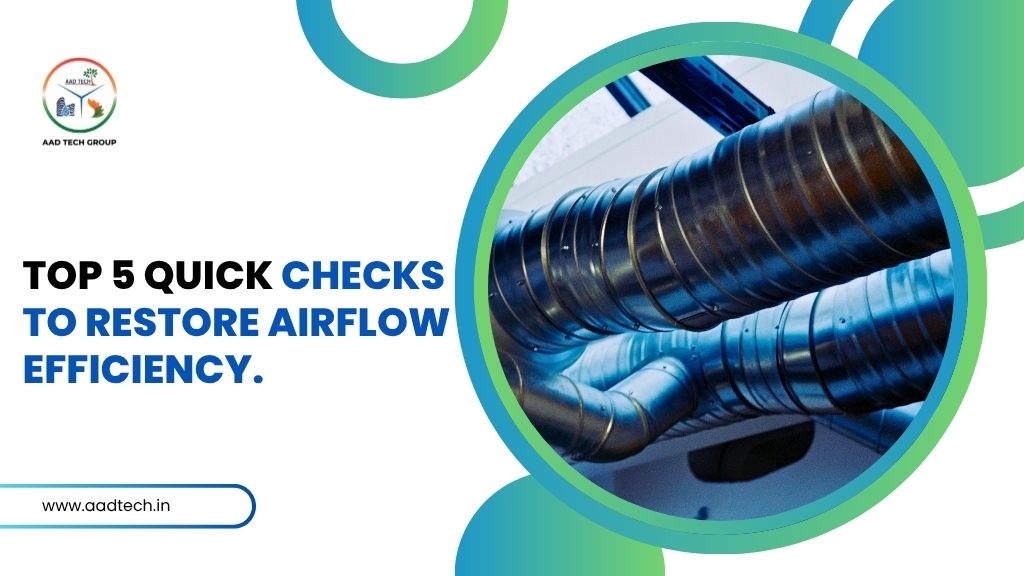Even the most advanced HVAC systems depend on a well-functioning Air Handling Unit (AHU) to maintain indoor air quality, temperature, and humidity. When an AHU begins to underperform, whether due to poor airflow, uneven cooling, or incorrect humidification, the impact spreads quickly across the entire facility.
Understanding how to identify and fix common AHU problems can help facility managers prevent downtime and extend equipment life. Drawing from years of field experience in AHU retrofit, AHU refurbishment, and energy saving retrofit projects, our engineers at Aad Tech have compiled five practical troubleshooting tips that keep AHUs running efficiently and reliably.
1. Check for Airflow Imbalances
Poor airflow is among the most common AHU issues. It can result from clogged filters, misaligned dampers, or worn fan belts. Begin by verifying the static pressure across filters and coils. If readings are unusually high, obstruction or dirty filters are likely culprits.
In modern systems, especially those upgraded during an AHU retrofit, airflow imbalance may stem from improper sensor calibration or mismatched fan speeds. According to the Bureau of Energy Efficiency (BEE, 2017), maintaining balanced air distribution across ducts improves both energy efficiency and indoor air comfort (BEE, 2017).
Regular audits using anemometers or differential pressure sensors help maintain consistent airflow and reduce system strain.
2. Inspect the Fan and Motor Assembly
The fan and motor assembly is the core of any AHU. Worn bearings, misalignment, or excessive vibration are early warning signs of failure.
For older systems, replacing traditional fans with EC centrifugal fans provides a significant efficiency boost. EC (Electronically Commutated) fans use integrated electronic control and brushless DC motors, allowing variable speed and quiet operation. In one AHU refurbishment project at Aad Tech, replacing belt-driven units with EC centrifugal fans improved airflow stability and reduced power consumption by almost 55 percent
Routine vibration analysis and lubrication keep the fan assembly reliable and energy efficient.
3. Evaluate the Cooling and Heating Coils
If the AHU fails to reach target temperature, check heating and cooling coils for dirt or scale buildup. Fouled coils restrict airflow and heat transfer.
The clean coils can restore up to 15 percent of lost HVAC efficiency (Thermal Control Magazine, 2023). Use coil-cleaning agents suitable for your coil’s fin material and rinse thoroughly to prevent residue.
For humid or coastal regions, consider protective coatings during your next energy saving retrofit. This small step helps prevent corrosion and improves long-term thermal performance.
Explore a practical retrofit for pharmaceutical air handling systems at AHU for Pharmaceuticals: A Practical Approach to Retrofitting, which guides you through upgrading existing AHUs without full replacement.
4. Examine Control Systems and Sensors
Modern AHUs rely heavily on sensors, actuators, and control logic. Faulty sensors can cause temperature swings, humidity imbalance, or continuous fan operation even during low demand.
Integrating smart controllers and demand-based ventilation modules can dramatically improve retrofit energy efficiency. The Energy Conservation Building Code (ECBC, BEE 2017) highlights that intelligent controls and variable-speed drives are essential for optimised HVAC performance (BEE ECBC 2017).
At Aad Tech, we evaluate each control circuit, recalibrate sensors, and integrate Building Management System (BMS) logic during every AHU retrofit to eliminate inefficiencies.
5. Review Maintenance and Operational Practices
Even the best equipment can underperform without proper upkeep. Skipped filter replacements, infrequent cleaning, or poor lubrication often lead to recurring failures.
A structured maintenance plan—especially after AHU refurbishment—ensures consistent operation. The BEE HVAC Design Guideline (2017) recommends scheduled inspections at least once every quarter to sustain system efficiency (BEE, 2017).
We advise clients to:
- Inspect filters and dampers monthly.
- Clean drain pans and ducts quarterly.
- Conduct annual fan alignment and electrical testing.
These preventive steps extend equipment life and safeguard the benefits of your energy saving retrofit.
Conclusion
Troubleshooting AHUs effectively combines engineering insight with disciplined maintenance. By inspecting airflow, monitoring fan health, cleaning coils, and ensuring proper control calibration, facility managers can prevent most performance issues.At Aad Tech, we pair troubleshooting with AHU refurbishment, IoT enabled over the air maintenance, energy savings, and integration of advanced EC centrifugal fans to help clients achieve higher reliability and lower energy use. A well-maintained AHU is more than a comfort system—it’s a key contributor to operational efficiency and sustainability.

